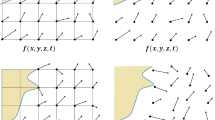Abstract
The migration of contaminants in heterogeneous aquifers involves dispersive processes that act at different scales. The interaction of these processes as a plume evolves can be studied by micro-scale modelling whereby two scales, a local- or micro-scale and an aquifer- or macro-scale, are covered simultaneously. Local-scale dispersive processes are represented through the local dispersion coefficient in the transport equation, while large-scale dispersion due to heterogeneities is represented through the resolution of the flow field and the diffusive exchange between streamtubes. The micro-scale model provides both the high degree of resolution compatible with local-scale processes, and the extent required for the approach to asymptotic conditions, using grids of up to a million nodal points. The model is based on the dual potential-streamfunction formulation for flow, and the transport problem is formulated in a natural coordinate system provided by the flownet. Simulations can be used to verify stochastic theories of dispersion, without the restrictive assumptions inherent in the theory. For the two-dimensional case, results indicate convergence of the effective dispersivity to the theoretical macrodispersivity value. Convergence takes place within a travel distance of about 50 correlation lengths of the hydraulic conductivity field. However, the approach taken to asymptotic conditions, as well as the macrodispersivity value, may differ for different realizations of the same medium. The influence of early-time events such as plume splitting on the asymptotic convergence remains to be investigated.
Similar content being viewed by others
References
Dagan, G. 1982: Stochastic modeling of groundwater flow by unconditional and conditional probabilities. 2. The solute transport. Water Resour. Res. 18, 835–848
Daus, A.D.; Frind, E.O.; Sudicky, E.A. 1985: Comparative error analysis in finite element formulations of the advection-dispersion equation. Advances in Water Resources 8, 86–95
Frind, E.O. 1982: The Principal Direction Technique: A new approach to groundwater contaminant transport modelling. Proc., 4th Int. Conf. on Finite Elements in Water Resources, Springer-Verlag, New York, 13.25–13.42
Frind, E.O.; Germain, D. 1987: Simulation of contaminant, plumes with large dispersive contrast: Evaluation of Alternating Direction Galerkin Techniques. Water Resour. Res. 23, 1857–1873
Frind, E.O.; Matanga, G.B. 1985: The dual formulation of flow for contaminant transport modeling: 1. Review of theory and accuracy aspects. Water Resour. Res. 21, 159–169
Frind, E.O.; Pinder, G.F. 1982: The Principal Direction Technique for solution of the advection-dispersion equation. Proc., 10th IMACS Conf., Scientific Computing, North-Holland, Amsterdam, 305–313
Gelhar, L.W.; Axness, C.L. 1983: Three-dimensional stochastic analysis of macrodispersion in aquifers. Water Resour. Res. 19, 161–180
Gillham, R.W.; Sudicky, E.A.; Cherry, J.A.; Frind, E.O. 1984: An advection-diffusion concept for solute transport in heterogeneous unconsolidated geological deposits. Water Resour. Res. 20, 369–378
Kinzelbach, W.K.H.; Frind, E.O. 1986: Accuracy criteria for advection-dispersion models. Proc., 6th Int. Conf. on Finite Elements in Water Resources, Springer-Verlag, New York, 489–501
Mackay, A.; Freyberg, D.L.; Roberts, P.V.; Cherry, J.A. 1986: A natural gradient experiment on solute transport in a sand aquifer: 1. Approach and overview of plume movement. Water Resour. Res. 22, 2017–2029
Mantoglou, A.; Wilson, J.L. 1982: The Turning Bands Methods for simulation of random fields using line generation by a spectral method. Water Resour. Res. 18, 1379–1394
Neuman, S.P.; Winter, C.L.; Newman, C.M. 1987: Stochastic theory of field-scale Fickian dispersion in anisotropic porous media. Water Resour. Res. 23, 453–466
Schellenberg, S.L. 1987: Groundwater flow and non-reactive tracer motion in heterogeneous statistically anisotropic porous media. M.Sc. thesis, Dept. of Earth Sciences, Univ. of Waterloo
Sudicky, E.A. 1983: An advection-diffusion theory of contaminant transport for stratified porous media. Ph.D. thesis, Dept. of Earth Sciences, Univ. of Waterloo
Sudicky, E.A. 1986: A natural gradient experiment on solute transport in a sand aquifer: Spatial variability of hydraulic conductivity and its role in the dispersion process. Water Resour. Res. 22, 2069–2082
Author information
Authors and Affiliations
Rights and permissions
About this article
Cite this article
Frind, E.O., Sudicky, E.A. & Schellenberg, S.L. Micro-scale modelling in the study of plume evolution in heterogeneous media. Stochastic Hydrol Hydraul 1, 263–279 (1987). https://doi.org/10.1007/BF01543098
Accepted:
Issue Date:
DOI: https://doi.org/10.1007/BF01543098




